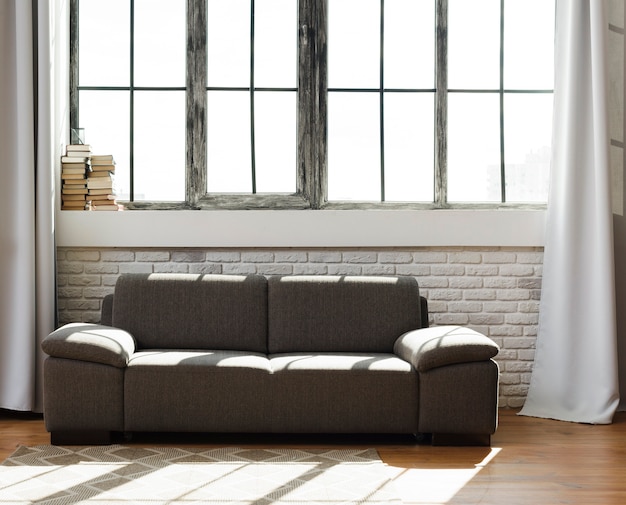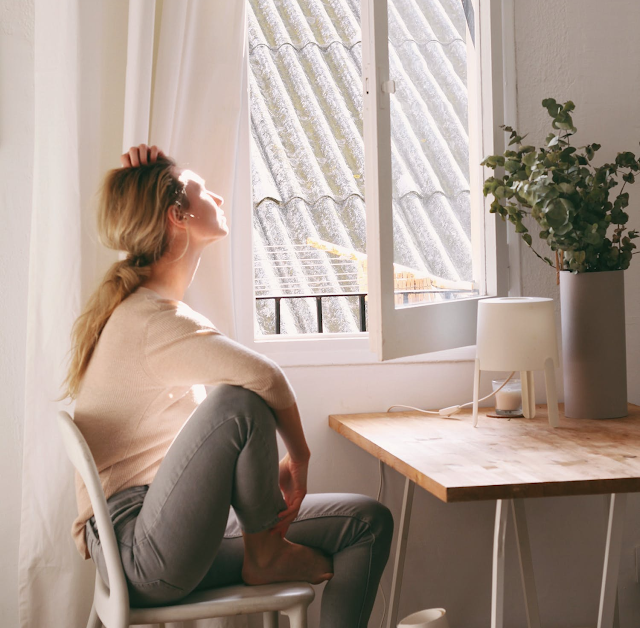Scandinavian design is a design movement that became popular in furnishing and interior decoration around the 1950's and it has an enduring influence on home decor trends ever since. Scandinavian design is one of those few trends that where able to develop over time and adapt to the desires and requirements of several generations since its appearance.
Read on to learn the key characteristics that Scandinavian interiors share in common beside linen cushions, sheepskin and candlelight and find ideas on what elements to include if you are creating a Scandinavian room or home interior. To know more about this trendy style you may also like to see our post on:
What Are the Main Characteristics of Scandinavian Design?

DECLUTTERED SPACE- signature characteristic of Scandi homes
Guided by the concepts that “less is more” and "form follows function" Scandinavian interior design principles are concentrated around maximum functionality and style with minimum clutter. Simplicity is the mantra of modern Scandinavian design so the first and foremost characteristic of Nordic spaces is the lack of clutter. Scandinavian design has an unfussy and clean approach to decorating so most of the used accessories are functional and practical. Storage is wisely implemented in both house and furniture design. The only "extras" that appear above strictly functional furnishing are decor accessories for extra light and extra coziness.
LIGHT - The General Trademark of Scandinavian Interiors
Natural LightingLight, and especially daylight is the focal point of this trendy decoration style because daylight is a luxury during the long winters in the north. The Nordic area of Europe, the region where Scandinavian design has been started and developed, is marked by long, dark winters with as little as 7 hours of light during the days. This darkness in the outer environment is most probably the reason why the interior designers from Scandinavia favor bright and airy spaces. This preferences for natural light translates into large windows when it comes to home designing. The rooms are designed with large windows to let in plenty of natural light and walls are usually painted in pale color schemes to reflect light and brighten the space.
Curtains - or rather the lack of them
It is typical in Scandinavia to use only a few window treatments if any. During my travels in the region I noticed that many Scandinavian homes do not use curtains at all and even those that have curtains do not shut them during the night. It is easy to understand the benefit from that as large windows with no curtains allow ample amount of natural light in during the day to brighten the spaces and provide an uninterrupted view of the outdoors. But it also raises some questions about intimacy and private life when it comes to the evening hours for all those who grew up in areas where curtains are the norm.What is behind this no-curtains approach in Scandinavia? Research shows that the reasons are various.
One of the reason why curtains are almost always open letting anybody walking past see what is going on in that home has a religious background. It shows that you and your family have nothing to hide. From that ground this curtain-less living grew into a Scandinavian social norm. People find that they connect this way with their neighborhoods. Leaving curtains open in the house shows an openness to share and connect. For some people the reason can be less poetic and rooted more in a willingness to simply show-off.In those Scandinavian homes where there are curtains they are there mostly for aesthetic reasons and as such they are part of the changing seasonal decoration. Curtains are changed at least twice a year but it is more typical to change them every season. Around winter time the Christmas curtains come out and then get exchanged for the spring-summer curtains. There are families who have different decorative curtains for the summer and others for the fall but it is way more typical to have just a white semitransparent linen curtain hanging near the window without really being used.
Candle light and ambient lights
Candles are a must when it comes to creating a Scandinavian interior. People traditionally place candles and lamps not only scattered around in the house but also in their windows. It is one very typical Scandinavian element to place a lamp or a candle in every window even if there is no holiday season. During holiday season these lamps are changed for more decorative and season specific illumination.
Scandinavian lighting fixtures are modern, simple and neutral. They are characterized by the same clean lines as Scandinavian furniture and other home accessories. Due to the short da ylight hours for quite large part of the year, Scandinavians use several type of lighting in their homes. Pendant lights are the most typical, hanging above kitchen islands, dining tables, staircases, nightstands. Beside hanging light fixtures it is typical to have table lamps, floor lamps and even a window lamps.
ylight hours for quite large part of the year, Scandinavians use several type of lighting in their homes. Pendant lights are the most typical, hanging above kitchen islands, dining tables, staircases, nightstands. Beside hanging light fixtures it is typical to have table lamps, floor lamps and even a window lamps.
 ylight hours for quite large part of the year, Scandinavians use several type of lighting in their homes. Pendant lights are the most typical, hanging above kitchen islands, dining tables, staircases, nightstands. Beside hanging light fixtures it is typical to have table lamps, floor lamps and even a window lamps.
ylight hours for quite large part of the year, Scandinavians use several type of lighting in their homes. Pendant lights are the most typical, hanging above kitchen islands, dining tables, staircases, nightstands. Beside hanging light fixtures it is typical to have table lamps, floor lamps and even a window lamps.In Scandinavia putting lamps in the window is very popular mainly in the countryside and can be rooted in the fact that lighted windows give an idea of warmth. It is nice to look around and see that others are there around you not just darkness. Beside being aesthetically beautiful it is also practical as it basically say: "This is a home and we are at home" It has this feeling to it that light can scare away burglars, strange people and spirits from approaching the home.
FUNCTIONALITY - An important feature of the Scandinavian style
Prioritizing functionality without eliminating beauty is the essence of Scandinavian design . The almost minimalist, airy, clutter free design and practical organization of spaces is one of the reasons why Scandinavian designed has gained such a popularity. Scandinavian design is simple yet sophisticated and it brings beauty and style into the everyday homes. Scandinavians do not want to fill their rooms with superfluous, artistic furniture so they create functional homes and furniture with taste and style.
The principle of Scandinavian design is to create functional yet sophisticated spaces. The practicality of each piece is carefully considered so each piece in the house serves at least one purpose. This mentality is true also when it comes to layouts and arranging spaces. Rather than serving just one function Scandinavian spaces tend to be open-plan, flexible spaces which could accommodate a variety of activities. Breakfast bar can double in a Scandi home as a home office desk and dining rooms often serve as family rooms and play areas.
Clean Lines and Airy Spaces
Clean lines provide striking simplicity and serenity in the home design so it reappears in both Scandinavian furnishing and in interior decoration. Scandinavian design has a defining clean look. While ensuring both comfort and sophistication designers tend to use shapes and textures with simple lines and forms.The patterns are typically simple and symmetric. Their ideology is that simplicity creates calmness and serenity in the home. The preference of the Scandinavian style for simple, clean lines is understandable as their is always elegance in balance and simplicity.
NATURAL ELEMENTS - create a feeling of connection and oneness with nature
Scandinavian decor typically meets modern design with natural elements. designers and homeowners like to bring the outdoors inside, which means large windows with uninterrupted view to the garden, incorporating natural wood floors, drift wood accent pieces and potted indoor plants. Scandinavian design is an early promoter of eco-friendly materials and natural, healthy homes with organic, sustainable flooring, furniture and roofing.Natural Textures
Inspired by nature not only are floors typically made of wood, but it is widespread to find wood wall features, wood wall art, distressed boards, wood headboards and rustic wood accent pieces in the Nordic homes. In Scandinavian design you won’t see wall-to-wall carpets rather you will find natural wood floors and some area rugs. Natural looking rugs add warmth, coziness, layer and texture to the neutral, light wood floors.
Inspired by nature not only are floors typically made of wood, but it is widespread to find wood wall features, wood wall art, distressed boards, wood headboards and rustic wood accent pieces in the Nordic homes. In Scandinavian design you won’t see wall-to-wall carpets rather you will find natural wood floors and some area rugs. Natural looking rugs add warmth, coziness, layer and texture to the neutral, light wood floors.
Plants
Continuing with the natural theme Scandinavian designers bring in plants, branches, stones to create an unfussy, organic feel to spaces. With a focus on simplicity and minimalism Scandinavian design matches well with indoor plants of all sizes. Plants are not only purifying indoor air but add a spot of color to the otherwise laid back, pastel, white dominated interiors.

HYGEE- contentment and coziness
Last but not least the Scandinavians are cozy people and that characterizes their interiors too. Due to the cold and shortly lit winter days people spend a lot of time in their homes so it is natural that they want it to be cozy, welcoming and comfortable. There is a concept called Hygge that is becoming more and more embraced globally, which is like an opposite to the modern world stress. Hygge is the contentment one feels when enjoying the simple things in life, like drinking a tea and reading a book.
Scandinavian decorating and living promotes a laid back lifestyle so it’s common to find pillows and blankets placed on the floor as well.

Sources, inspiration, further readings:
Scandinavian Interior Design Characteristics
 Reviewed by Sofia
on
9:19 PM
Rating:
Reviewed by Sofia
on
9:19 PM
Rating:
 Reviewed by Sofia
on
9:19 PM
Rating:
Reviewed by Sofia
on
9:19 PM
Rating:





No comments: